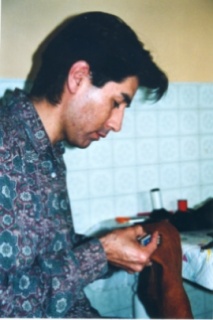|
|
Early Northern Plains moccasins had soft soles and were made in one piece, folded with a side seam. This type of moccasin was known as "niit-tsi-tsi-kiin" (the true moccasin), a term that was shared among the three divisions of the Blackfoot (Kainaiwa (Blood), Pii-kunii (Peigan), and Siksika (Blackfoot)). Today all moccasins are referred to in this way. The two-piece moccasin with stiff rawhide soles and soft uppers probably came into being with the advent of the horse, when nomadic people began to move in greater distances over the Prairies.
Men, women, and children all wore the same style moccasin; only the size differed.
Moccasins were fashioned with tanned buffalo, elk, moose, and deer hides. Later, domestic cowhides were used; a sign of hardship among Native people that meant wild game was scarce. Hides were either white or smoked, depending on their purpose. Everyday moccasins were left plain while decorated ones were used for special occasions.
Before the introduction of seed beads, dyed porcupine quills were used for decoration. An example of quillwork with seed beads appears on CMC V-B-331 a,b. This pair was probably used for special occasions like an "all-smoke ritual," which required the wearer to sit for long periods of time, allowing the beaded soles to be admired. The moccasins also show some traces of red-ochre paint, which indicates that they were used for ceremonial purposes. Since doing quillwork was considered a sacred task, a woman had to go through a brief ceremony of initiation before taking up this art form.
One of the earliest designs used was "miista-tsoka-tuksiin," or mountain design. Other designs included squares, diamonds, bars, slotted bars and stripes, the latter a beaded version of the early quillwork of the straight quill tied-sinew method. Today such designs are called "maah-toohm-moowa-ka-na-sksin," or first designs.
Floral designs were also referred to in this way, even though they were influenced by European motifs (see CMC V-B-351 a,b as an example.) These patterns were done in bilaterally symmetrical form and use geometric designs to depict non-realistic flowers.
During the seed-bead period (1840-1870), beadwork changed in technique and in the use of colour, which allowed the beadworker to produce more intricate forms. Two methods of beadwork were the spot stitch or appliqué and lone stitch or lazy stitch.
Trade cloth, used on cuffs and fill-in, was also introduced in addition to seed beads. See CMC V-B-429 a,b and V-B-40 a,b for examples where red trade cloth has been used around the cuff. This design, which featured three prongs stemming out from the half circle, is called the three-finger or half-breed design. It is usually filled in with trade cloth; an indication that hides had to be salvaged. The ankle wrap has also been replaced by canvas, another sign of hardship.
By this time, domestic cowhides were being used to make clothing, and rawhides used for hard moccasin soles.
Favoured colours included shades of green, blue, red, white, yellow, pink, black, and sometimes orange. Blue and white were preferred for background beadwork among the Blackfoot (see CMC V-B-432 a, b).
Most of the earlier moccasins had ankle wrap-arounds for both men and women (it was much easier for women's leggings to fit over this additional piece of hide). The lower-cut moccasin became more popular during the 1930s to the 1940s. It is unusual to see beadwork on moccasins such as that on CMC V-B-340 a,b, even though it is a typical geometric design.
Contemporary moccasins rarely use traditional patterns and materials, as most designs are borrowed from other North American tribes. Still, a few moccasins being produced by both male and female beadworkers today continue to follow the old designs. See CMC V-B-606 a, b and CMC V-B-591 a, b for good examples of the mountain design, a blue background, and a traditional Blackfoot floral design.
